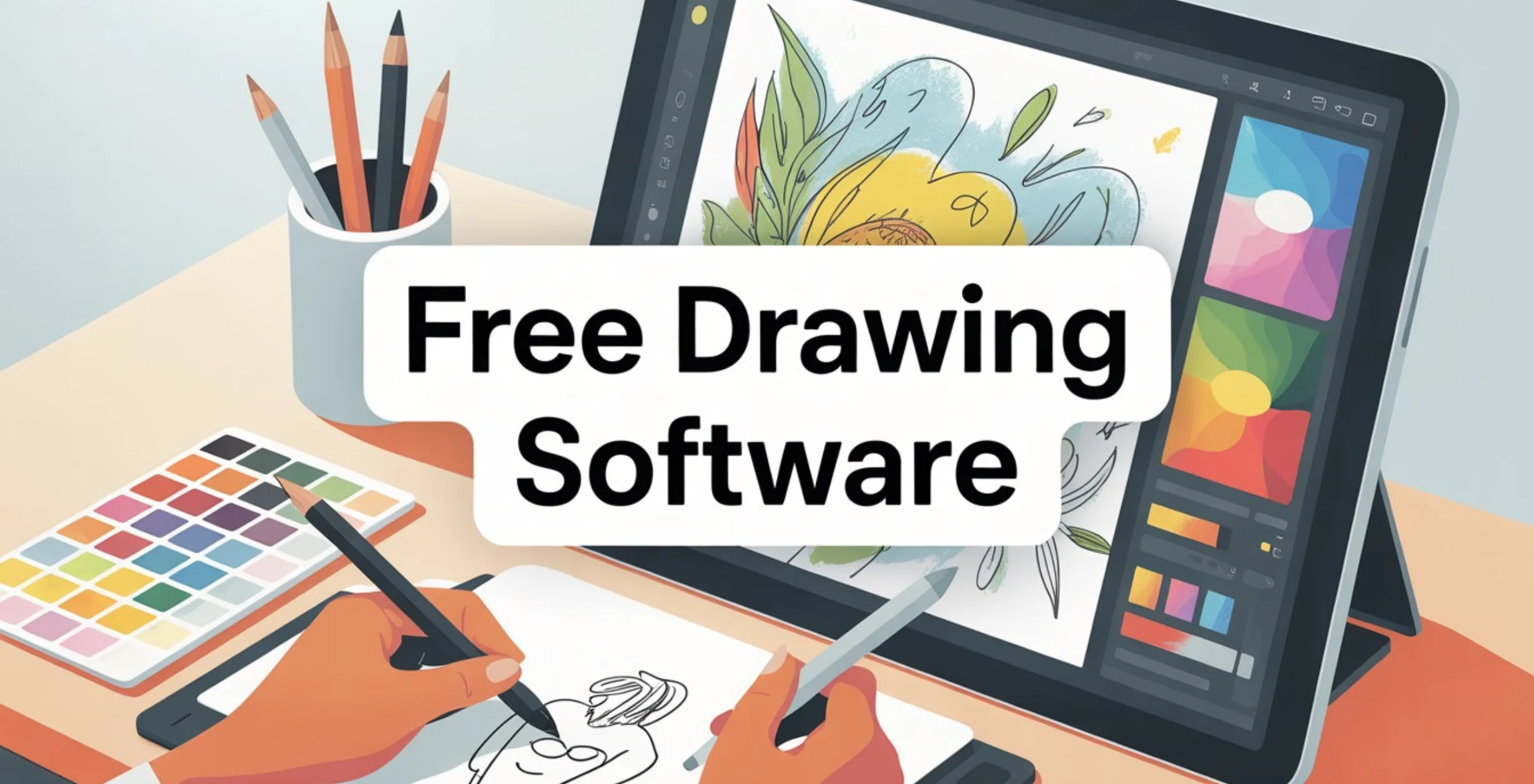It feels like magic, doesn’t it? You enter a couple of words and you can see a video. You are moving around with your phone and on the screen you see a 3D model of the object. This is not a sci‑fi movie. This is our world in 2026.
Artificial intelligence (AI)-based tools are increasing at a pace that no one has ever imagined. Nowadays, it was extremely difficult to create a 3D model or a cool animation video a few years ago. It required specialists that had costly computers and challenging software. Millions of individuals are now making incredible things every day on their phone or laptops, students, artists, small business owners, often exploring Luma AI Alternatives to find the best creative tools that suit their needs..
The generative AI (AI that makes things) is a massive world. By 2026, individuals will be spending more than 55 billion USD on this type of AI products. That demonstrates the extent to which we enjoy AI creation. Meanwhile, the 3D capture (equipments to scan real-life objects) market is also massive. It should be valued above 10 billion dollars this year. These figures reflect only one thing, that is, more people are creating more cool digital stuff than ever.
Luma artificial intelligence (AI) is one of the most popular tools that can perform this magic. But is it the only one? Not at all! The world contains wonderful tools, and each of them is unique. We shall see what Luma AI is and what the most suitable alternatives will be in 2026.
What is Luma AI? A Quick Look
Imagine Luma AI is a magic box with various tricks. It began with doing one thing very well and then acquired other new and exciting skills.
Luma First Magic Trick: 3D on Your Phone.
Luma AI was known due to 3D capture. People loved it. One would pick up his or her phone, open the Luma app, and record a video as he or she walks around an object. It may be your new sneakers, your favorite toy or even a statue in the park.
This video would then be forwarded by you to Luma. Within several minutes, the intelligent AI of Luma would analyse all the images in your video, consider the object on all sides, and create a 3D representation of it.
Luma The New Magic Trick: Turning Words into Videos.
AI became cleverer, and Luma AI acquired another fantastic ability, which was the one known as the generative video. It is what people refer to as Luma Dream Machine.
You do not even require a camera with this one. All you have to do is use your imagination. The button is pressed and you type a sentence such as A happy robot dancing in the rain on Mars, and the AI Luma reads what you are saying and thinks about the meaning of your words and makes you a video.
Other New Tricks of Luma Making 3D out of Words.
Genie is another tool that Luma possesses. It is similar to Dream Machine, except in 3D models.
Type, a little, red treasure chest, gold-locked. The AI of Genie thinks and constructs a 3D image of that very treasure chest. It does not require scanning anything. You just type.
This comes in so handy with game makers or designers. In case they require ten varieties of trees to play their game, they need only to request the AI to create them. It saves a huge amount of time.
Luma AI is therefore a strong tool that not only can generate the real world in 3D, but also generate new 3D models and videos based on your words.
Why are Luma AI Alternatives to be considered?
So great is Luma AI, why bother to seek something more? Consider purchasing a jacket. One jacket could be a super-high technology coat that is waterproof, warms up and has a music player. However, when you simply want to have a soft jacket to wear at home, that hi-tech coat may be too expensive or too complex.
This is the same case with software. Luma is awesome, but not everybody is going to like it.
- In case you only require a single trick: Luma 3D scanning and AI video. Should you just be interested in 3D scanning, then you may come across a tool that specializes in scanning and scans it even better or easier. Or, when you simply want to create AI videos and do not even think about 3D models,
- You Need a Different Price: There is no cost to using the Luma AI, yet the most impressive results require money. There are alternatives that may include a superior free plan. The other tools may be completely free. There are other pro tools which may be pricier, but offer you capabilities that Luma does not offer.
- You Need Something Easier (or More Powerful): Luma is rather simple, and some of the people may be confused by it. You may desire a device that has only a single large button that is marked Make 3D. A professional 3D artist on the other hand may desire additional control. They may desire a tool that has 100 buttons that enable them to alter every smallest detail.
- You Need It on Your Device: There are those tools that are best used in an iPhone with a special sensor. Other applications are compatible with any Android phone. Others do it with a strong windows computer. It should have a tool that works in your work place.
- You Just Want to Try something new: You know, it is pleasant to find what is available! Various instruments provide dissimilar outcomes. An AI video creator can create something that resembles paintings. One can create something that appears highly real.
We suggest you to check this blog also AI Language Translation Tools
Top 10 Luma AI Alternatives in 2026
We shall now examine each tool in more detail. We are going to examine tools competing with 3D scanning of Luma as well as tools competing with AI video and 3D creation of Luma.
Category 1: 3D Scanning Alternatives (Similar to 3D capture by Luma)
The tools are all concerned with the transformation of real-world images into 3D images.
1. Polycam
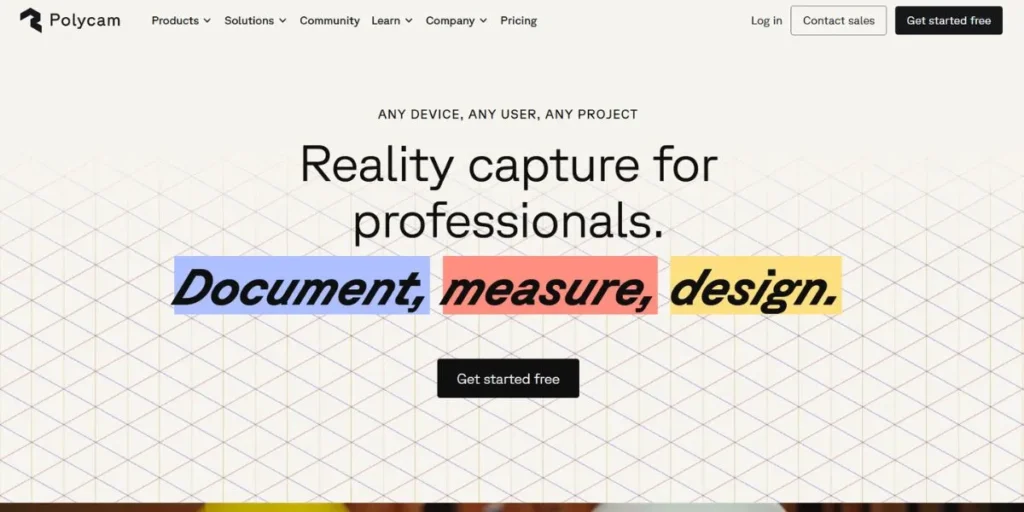
Polycam is among the most dominant and famous 3D scanning applications and is often mentioned when people explore Luma AI Alternatives for realistic 3D capture. Consider it as the pro choice of your phone. It works very well in the taking up of big areas such as rooms or entire buildings. Polycam can also use a LiDAR scanner (a special laser sensor) that is found on certain iPhone models to take highly fast and precise measurements.
It is as though you are painting the world in 3D. Even without LiDAR, it is excellent on Android and the slightly older iPhones with only your camera. You have lots of photos and Polycam sews them in the cloud. Architects use it to present to the clients a 3D model of a house.
Key Features:
- Has LiDAR scanners which scan rooms quickly and accurately.
- Processes only photos (this is referred to as photogrammetry).
- Room Mode: Award-winning fast floor-plan.
- Allows you to measure distances in the 3D model.
- Share your scans with a link, and share them with a link, and people can view them in 3D or in Augmented Reality (AR).
Pros:
- 3D models of extremely high quality, particularly with LiDAR.
- Ideal when scanning large spaces and rooms.
- Easy to share your creations.
- Includes a great deal of good editing features within the app.
Cons:
- The free plan is limited. You need to spend to have the best quality.
- It is a little bit more complicated than other apps to a complete beginner.
- Uses a lot of battery.
Pricing:
Polycam offers a free plan whereby you can do some scanning and share. The Pro plan is required to have the best quality and save your 3D models in helpful formats (such as 3D printing or games). The Pro plan is an annual or monthly plan.
2. Kiri Engine
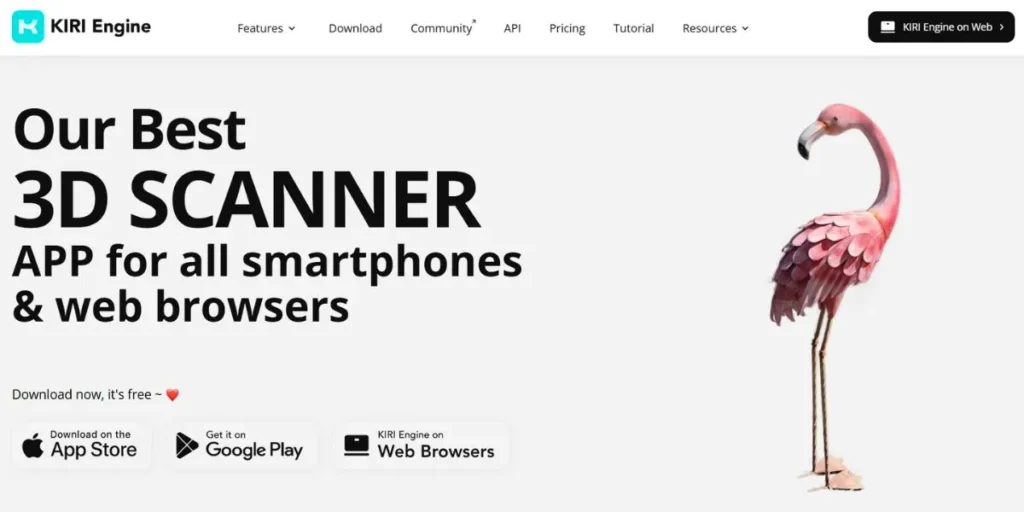
The Kiri Engine is the hero in the life of people who desire excellent 3D scans without an expensive and fancy phone. It is compatible with Android and iPhone without the need of a LiDAR sensor. It is everything about making use of your photos. The impressive fact about Kiri Engine is the free plan. It is very generous.
It is free to make numerous scans and save them. This makes it a big favorite amongst students, hobbyists and those people who are fond of 3D printing. You make approximately 70-100 photos of your object at every angle (Kiri Engine provides you with some advice on how to do so). Then you upload them.
Key Features:
- It works with virtually any smartphone (Android and iOS).
- Does not need a LiDAR sensor.
- Has a very good free plan.
- Edits the photos on the cloud, therefore, it does not slow down your phone.
- You are able to save your models in such popular forms as OBJ and STL.
Pros:
- Good with those who are budget conscious.
- Individual beginners can learn very easily.
- Final 3D models are of good quality and are helpful.
- Active community to help you.
Cons:
- It is also slow to process when there are a lot of people using it.
- Free plan may require you to wait in a queue (line) to get your model.
- Does not perform so well with shiny or transparent objects (such as glass).
Pricing:
Kiri Engine has an excellent free plan. It provides you with a free exportation of your model (on a weekly basis). In case you are a professional and you need to make numerous models quickly without delays, you can afford to buy a Pro plan. This provides you with increased processing and exports.
3. Meshroom
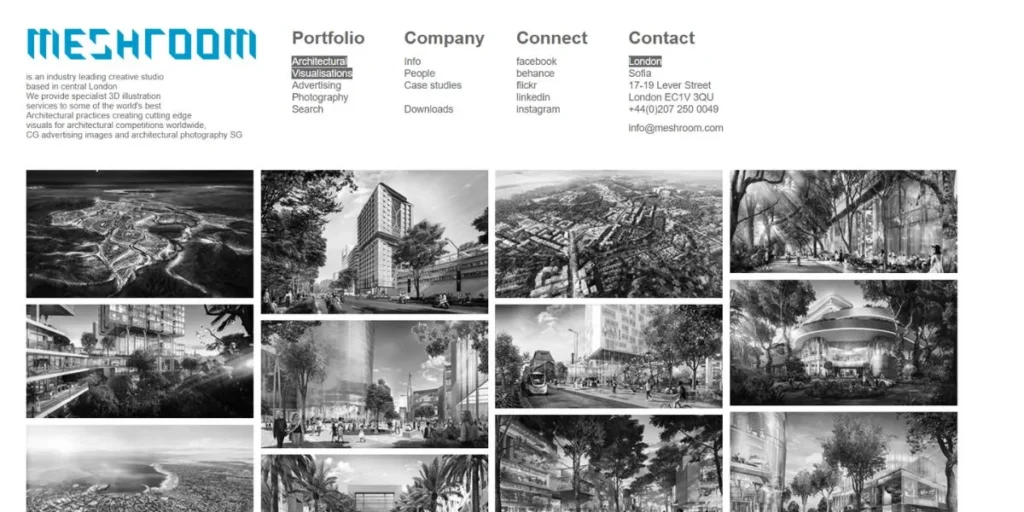
Meshroom is different. It isn’t a phone app. It is a free (100 percent) and powerful software that you install in the computer (Windows and Linux). Apply in the case you have to have a very detailed 3D model and you do not want to spend money.
The trade-off with it is that it requires a certain amount of technical knowledge. Meshroom creates a three-dimensional model containing small details and sharp textures (the picture of the skin). Scientists, historians (who scan old statues) and those who desire complete control are fond of it.
Key Features:
- – It is entirely open and open-source (you may view the code).
- – Uses your own computer, and therefore no data uploading is done.
- – Have the ability to process thousands of photos to produce large detailed models.
- – The settings are very customizable.
- – Supports pictures of any camera.
Pros:
- – 100 % free, forever. No subscriptions.
- – Is able to generate some of the highest quality 3D scans.
- – You are the owner of the entire process.
- – Ideal when big and serious projects are involved.
Cons:
- – It requires a high-performance computer with a decent graphics card (GPU).
- – It is not for beginners. It looks complicated.
- – It can be very slow. You may just leave it overnight.
- – It is not a simple phone app.
Pricing:
Free. Completely and totally free.
4. 3DF Zephyr
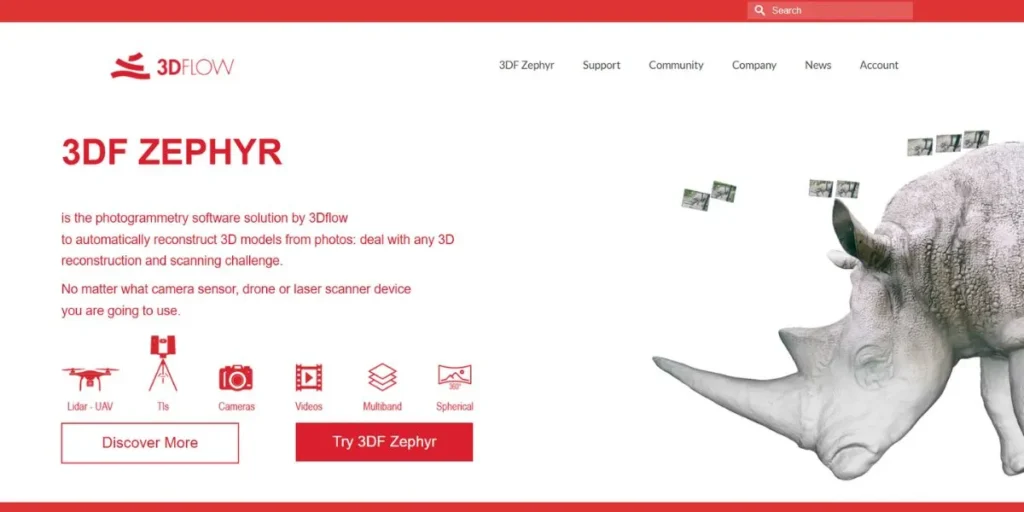
3DF Zephyr is a compromise between a basic application and an extremely complicated one, such as Meshroom. It is a windows based program. It has a free version that is excellent and suitable to students and beginners. The free edition allows one to use up to 50 photos to create a 3D model. This is ideal when one wants to know about 3D scanning and explore Luma AI Alternatives for photogrammetry.
You are able to scan a small item on your table. Full, paid editions of 3DF Zephyr are highly powerful and are deployed by the professionals who have drones to survey an entire piece of land. However, that 50-photo free version is an excellent starting point towards a beginner.
Key Features:
- – Free version with no limitations (up to 50 photos) is great, and beginners can use it.
- – Extremely powerful professional models.
- – Simple to operate as compared to most of the computer programs.
- – Gives you good, clean 3D models.
- – Has nice tutorials to assist you in learning.
Pros:
- – Free version is an ideal learning process.
- – Operates very well and is very quick.
- – You can grow with it. You can free-up and upgrade to a better version in case you get serious.
Cons:
- – The free version has a small limit of 50 photos. One can scan small things only.
- – It is applicable only to windows computers.
- – The versions that are paid may be costly to a hobbyist.
Pricing:
It has a free version. Next it has paid versions (such as Lite, Pro, and Aerial) which include additional functions and allow using more photographs.
5. Qlone
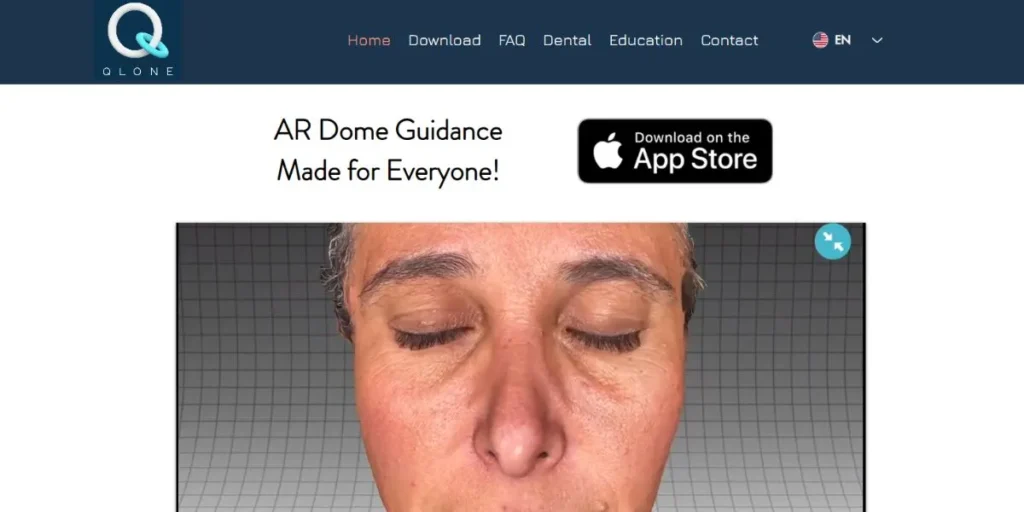
Qlone is everything about being straight forward and quick. It is an iPhone app (iOS and Android) with a very ingenious trick. It requests you to print out a piece of paper (black and white grid mat). Place your item on this mat at the center. Then open the application and you can see a 3D dome on your screen.
Take your phone around in order to fill in every area of the dome. The app takes pictures of the object on all its sides as you move. It is aware of the location of the object since it operates using the special mat. This renders the scanning very quick and simple.
Key Features:
- – Scans very easily and fast using a special printed mat.
- – Super- simple dome guide assists you to take all angles.
- – Works the model directly in your phone. No waiting for uploads.
- – Simple tools to clean-up and paint your 3D model.
- – You have an opportunity to export your model to 3D printers or transmit it online.
Pros:
- – This is probably the simplest and quickest 3D scanning application.
- – Excellent at the beginning, with children, and in school.
- – No need of a powerful phone or computer.
- – AR (Augmented Reality) view is entertaining. You are able to view your 3D model on your actual desk.
Cons:
- – It is necessary to use the printed mat, therefore you cannot scan a big statue in the park.
- – It does not have as high quality as such tools as Polycam or Meshroom.
- – Free application allows one to scan but you must pay a minimal charge every time you wish to save (export) a model.
Pricing:
The application is free to scan and download. You pay a little one time charge on each model you wish to export. Or you may purchase a ticket to unrestricted exports.
6. Trnio
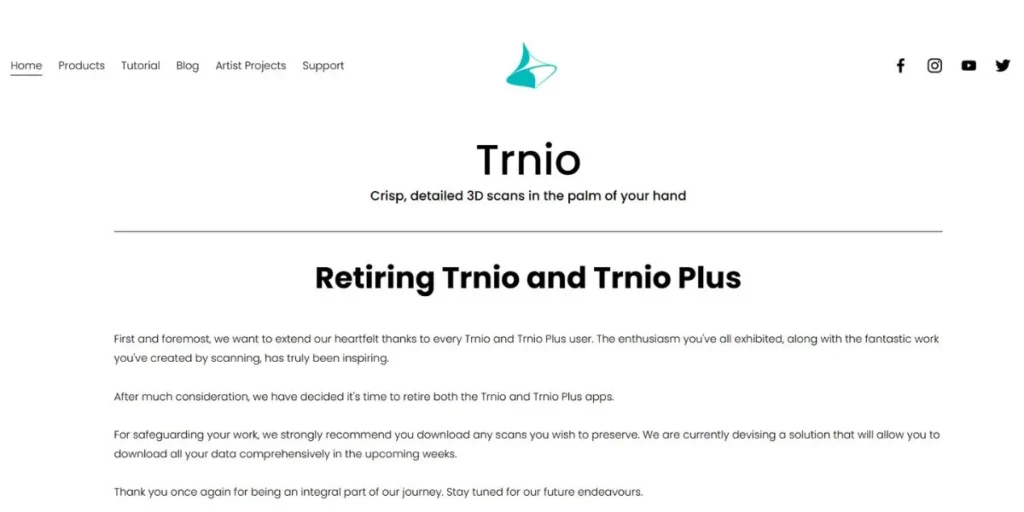
Another well-known iPhone app that has been in existence is Trino (Turn-me-oh). It is very easy to use. The app is opened, you press the button, and you walk around your object keeping it in the middle of the screen. That’s it. You are also able to take a lot of pictures within the app. The images are uploaded and run through the cloud, similarly to the Kiri Engine, which is often mentioned along with Luma AI Alternatives.
Trino is a no-fuss, solid tool that the iPhone users who need to take things on the go. It lacks the editing capabilities as Polycam, but works well when making quick and easy shots. It is usually used by artists to sketch what they observe on the street in a quick manner.
Key Features:
- Extremely easy to operate: point and walk.
- Works on iPhone.
- Cloud processes to save battery of your phone.
- Able to produce quality 3D images by use of photos.
Pros:
- Rapid and convenient to capture speedily.
- iPhone users who are not interested in a complicated application will find it good.
- You are able to post your scans to a social feed within the app.
Cons:
- Only for iPhone. Android users cannot use it.
- Not so many features as Polycam.
- It is not free, you need to purchase the app.
Pricing:
Trnio is a paid app. You make a single purchase in the App Store.
Category 2: AI Video and 3D Generation alternatives (Similar to Dream machine by Luma and Genie)
All these tools are concerned with making new things (videos or 3D models) out of what you say.
7. Runway (with Gen‑2)
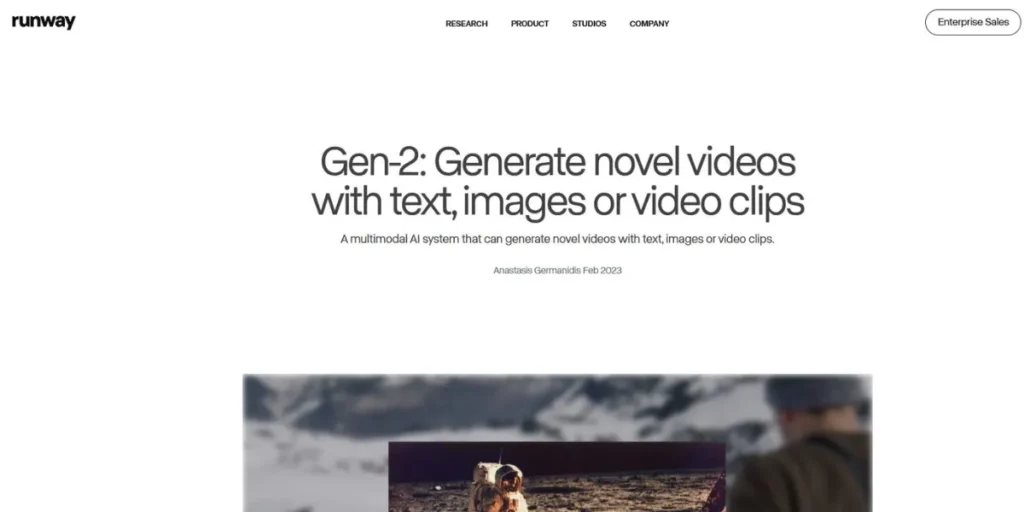
Runway is an enormous player in the AI creative field. It is an immediate and strong rival of the Dream Machine by Luma, often mentioned among the best Luma AI Alternatives. Runway is an AI based full movie-making studio. Its most famous tool is Gen‑2. Similar to Luma, a video can be obtained by typing words (a cowboy riding a zebra on the moon).
But the runway is more controllable. You have the option of uploading a photo and commanding it to move this photo. You are able to post a video and to alter the style in order to make it look like a clay animation. You can even paint some part of your video and instruct the AI to change this part.
Key Features:
- Gen-2: A highly potent text-to-video and image-to-video neural network.
- Motion Brush: This is an application in which you paint motion on a motionless picture.
- Video -Video: transform an existing video.
- A plethora of other AI magic tools (removal background, video enlargement, and so on).
- It is all web browser friendly.
Pros:
- Allows you to have an incredible mastery of your AI videos.
- The quality of the videos is frequently highly smooth and beautiful.
- It is not just one but a complete studio with numerous tools.
- They continually add new and powerful features.
Cons:
- It is more difficult to learn than Luma.
- Free plan provides you with certain credits, but they are not long-lasting.
- The cost of making videos is in credits, and you are likely to have to pay a subscription.
Pricing:
Runway has a free version with a small number of credits. These credits expire during the making of videos. To use it seriously, a monthly subscription must be purchased. This provides you with an increased amount of credits and quicker video making.
8. Pika (Pika Labs)
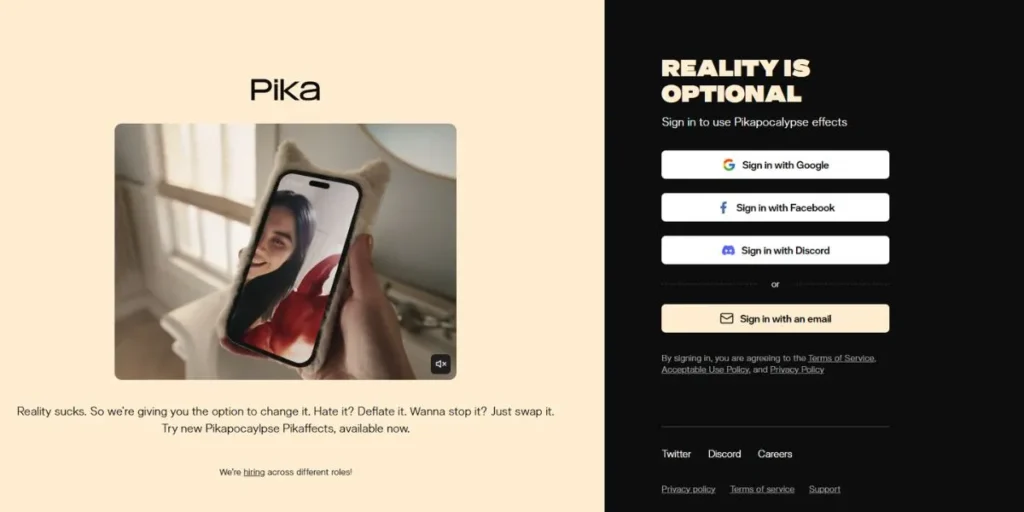
Another highly popular AI video maker that competes with Luma Dream Machine is pika. Pika gained fame as a highly creative and artistic person. Some of the tools attempt to be hyper-realistic, but Pika is excellent at making things appear stylized, such as anime, 3D cartoons or beautiful paintings.
It is also very easy to use. You write your thought and it provides you with a video. But there are also strong features of it. You are able to add your personal video and modify it. As an example, you can post a video of you dancing and write make me an anime character.
Key Features:
- Text-to-Video: Use words to create videos.
- Video-to-Video: make your own videos more stylish.
- Tilt Canvas: Resize your video to a larger (e.g. a square to a wide) size.
- Change Region: Edit only one part of your video.
- Excellent in numerous fashions of art.
Pros:
- Very easy to get started.
- Ideal with artistic non-realistic styles.
- Has a free version to give it a test run.
- The quality of the video is very high and innovative.
Cons:
- With the free plan a Pika watermark (their logo) is placed on your video.
- Videos are usually brief (in a few seconds).
- It has some weird mistakes similar to all AI video tools (such as a person with six fingers).
Pricing:
Pika is a free plan which allows you to create videos, with a watermark on them. In order to delete the watermark and make the videos fast, you must purchase a paid monthly plan.
9. Kling AI
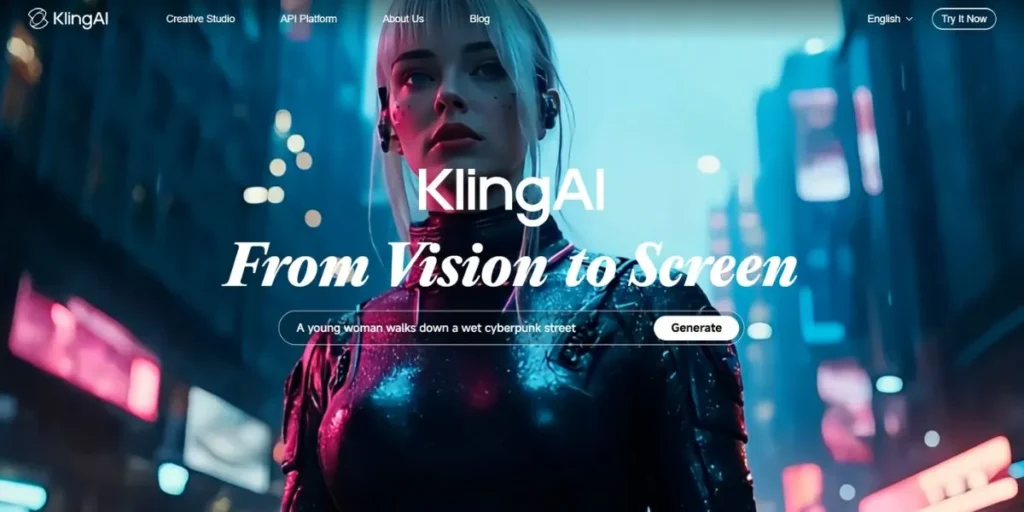
The new hit in the AI video is Kling, which people are watching in 2026. It is produced by a large technology firm known as Kuaishou, which owns a Tik Tok competitor in China. Kling stunned the minds since it has the capability of creating long videos, up to two minutes, that are very realistic.
It even knows the way of how real things move. Type in a glass ball rolling down a hill and crashing and Kling will know how a real glass ball would roll and break. That is hard for AI. Kling is also able to make high quality (1080p) video. Because of its impressive realism and extended video capabilities, Kling has quickly become one of the most talked-about Luma AI Alternatives for creators exploring next-generation AI filmmaking.
Key Features:
- Is able to make long videos (to 2 minutes).
- Has good knowledge of physics and motion in real world.
- Produces extremely good-quality videos that are realistic.
- Has the ability to change the aspect ratio (e.g. create a tall video on a phone).
Pros:
- The quality of video and realism is the best.
- Storytellers find it useful to make longer videos.
- It memorizes complicated concepts and gestures.
Cons:
- It is extremely recent and, therefore, one might not be able to get access to it.
- It may be still in a beta or testing stage and may have bugs.
- Since it is powerful, it can either be expensive or require long queues.
Pricing:
At the beginning of 2026, Kling will be restricted or waitlisted. You need to register and wait to have an opportunity to use it. The pricing will probably be similar to Runway and Pika, and it will be a subscription.
10. Synthesia
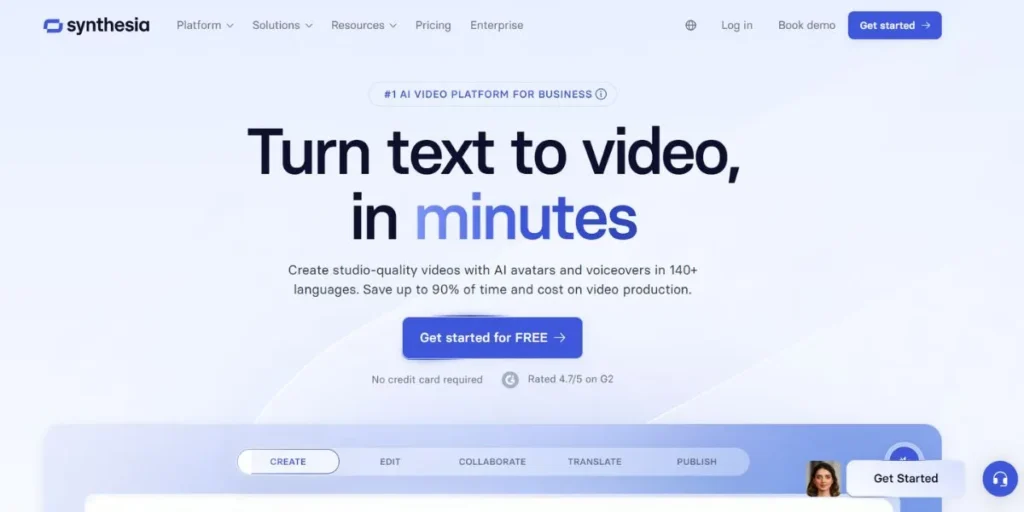
Another type of Luma ai alternative is called Synthesia. Luma can make product videos. Synthesia is a particular video: it is a video of a person speaking. The person is not real. It is an AI “avatar.” This can be of great help to business and teachers. You do not require an actor, lights, and a camera to have a training video in your company.
Just use Synthesia. Select an AI avatar among a list of more than 100 individuals. Type what you want them to say. Select a voice (more than 120 languages). Touch the make video button and a few minutes later you have a high-quality video of a fake person say what you said.
Key Features:
- More than 100 varieties of AI avatars.
- Speaks in more than 120 languages and accents.
- Extremely user-friendly: just write your script.
- You can upload your own voice.
- Features You can even make an AI avatar of yourself (on the costly plans).
Pros:
- Saves a lot of time and money to the businesses.
- Turns dull information into fun (such as training).
- The avatars are extremely realistic.
- It is easy to make videos in various languages.
Cons:
- It is not a creative tool of art or movie scenes. It only makes people talk.
- No free version, just a short free trial.
- It may be costly to an individual. It is meant for companies.
- AI avatars are a bit creepy to some individuals.
Pricing:
Synthesia is a subscription platform. It has single user plans and big team plans. It does not have a free plan, and they have a very short demo video on their site so that you can learn how to use it.
Conclusion
We live in an amazing time. The year 2026 is the year where you can only dream. You do not have to be a movie director in Hollywood to create a movie. It does not require a professional artist to create a 3D model. The world is full of choices. Polycam is the way to go in case you want to scan your room. Kiri Engine is a free 3D printing tool in case you want to print your toys.
To open Runway, and have a ton of control as an AI filmmaker. Pika is your friend, in case you simply want to create beautiful and artistic clips. These tools are some of the best Luma AI Alternatives available today, giving creators endless freedom to experiment and produce stunning visuals. There is no need to be concerned about identifying the number one best tool in the world. Pay attention to finding the best tool number one.
FAQs
Which is the most user-friendly free Luma AI option of 3D scanning?
Kiri Engine is likely to be the best in the case of a phone. It is free and is compatible with virtually any phone (Android or iOS). Meshroom is 100% free and highly powerful to a computer (and in case you are a bit tech-savvy).
Which is the most suitable Luma AI alternative to make realistic AI videos?
Kling AI and Runway (Gen-2) are competing on top of the table in 2026. They both can produce very realistic and high-quality videos that have a good command of movement and physics.
Are these apps able to scan clear or shiny objects such as glass?
All 3D scanning apps still find it difficult to scan shiny or clear objects. They make use of light that reflects on a surface. The AI is not sure of shiny or clear (as glass) objects.
Do I require a special phone to make 3D scanning?
No. Previously, you had to pay a lot of money on an iPhone with a LiDAR sensor. However, nowadays such tools as Kiri Engine work perfectly with a regular phone camera. They apply photogrammetry, a pretentious method of creating 3D by taking numerous 2D photographs.



